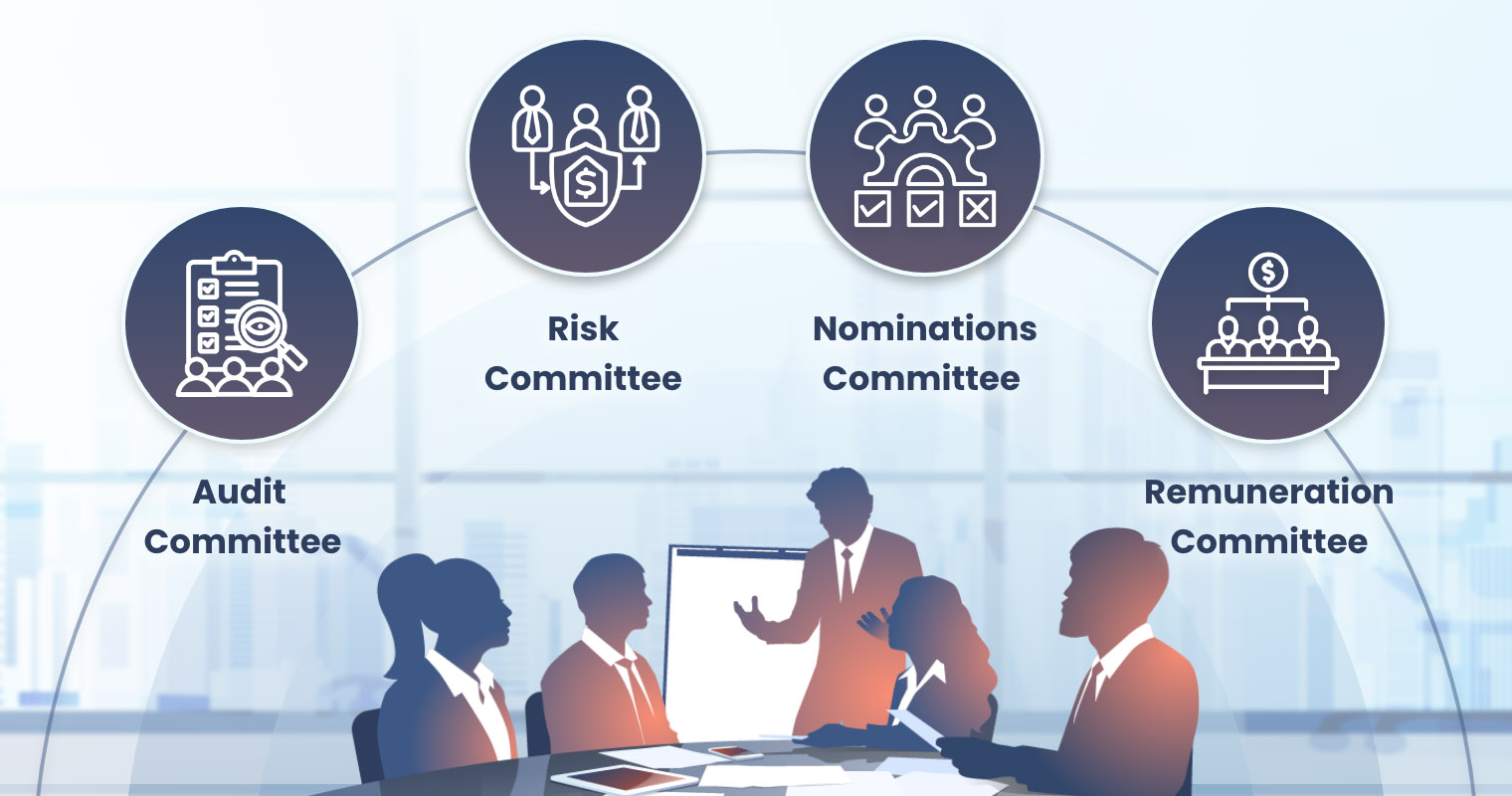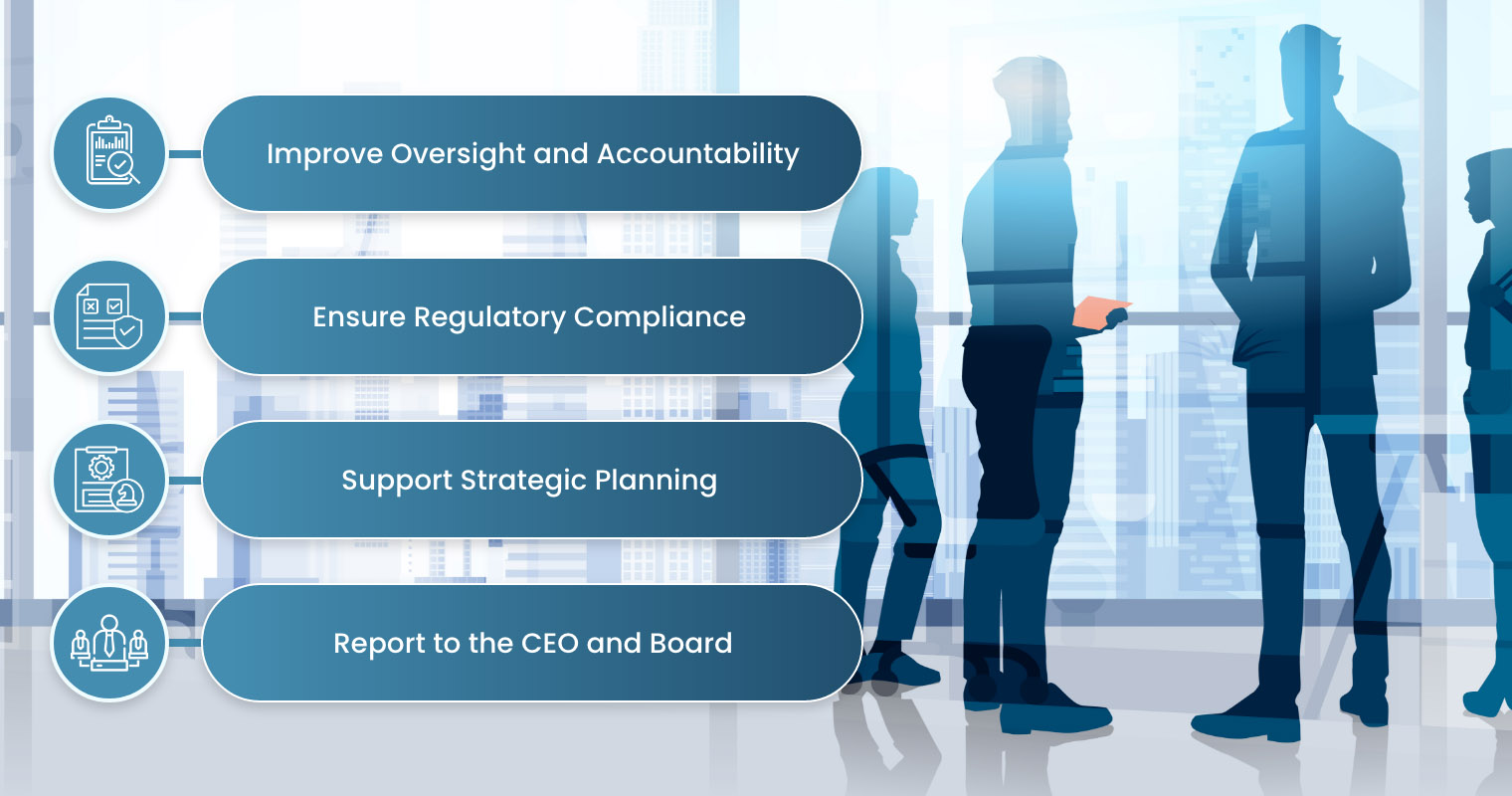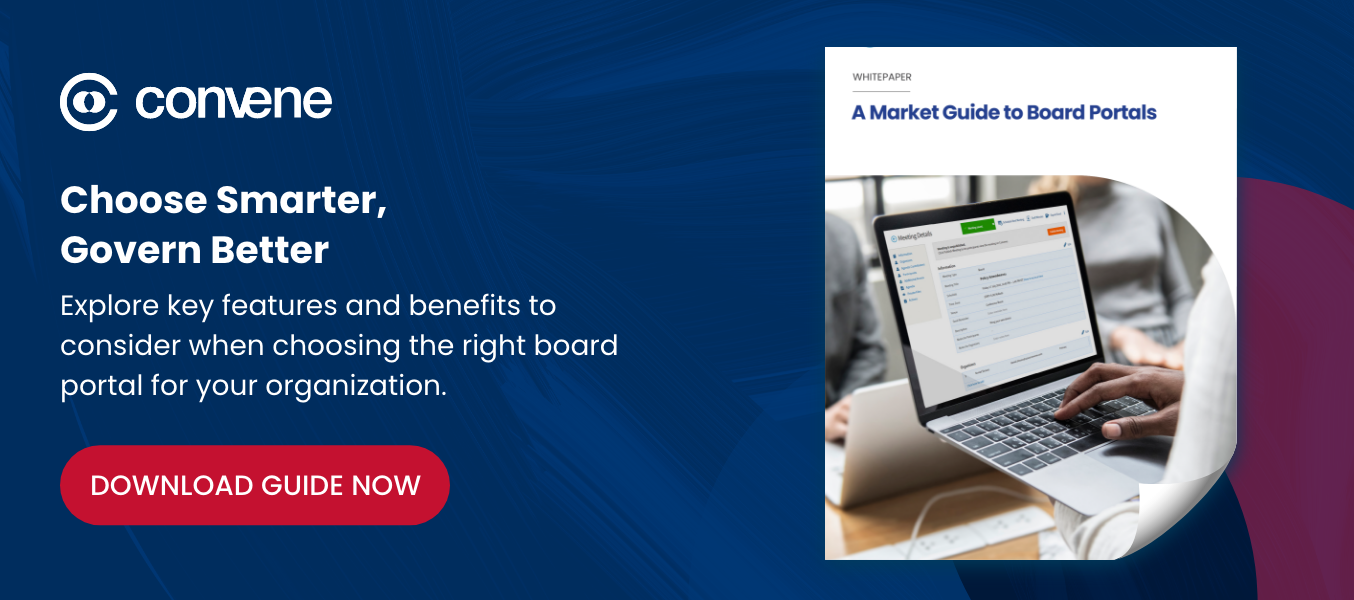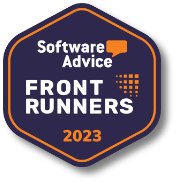Boards are known for guiding the organization’s overall operations and decision-making process. However, their duties are often broad in scope and may not cover specific operational concerns or issues. This is where standing committees come into play.
Boards and organizations form standing committees to dive deeper into specific areas that require specialized knowledge and skills — and most importantly, continuous oversight. Such committees not only improve efficiency by distributing workloads but also strengthen governance by ensuring continuous attention to critical issues. Read on to find out more about standing committees, from their key responsibilities to how boards assign committee members.
What is a Standing Committee?
A standing committee refers to a permanent, formally constituted subgroup within a governing body—a corporate board, legislative assembly, or not-for-profit organization. Unlike ad hoc or specific committees, which are organized to address temporary issues or projects, a standing committee operates indefinitely.
But what does the standing committee do? They are generally tasked with overseeing and executing critical operational, strategic, and governance-related functions that require continuous monitoring. This group is also governed by a formal charter or terms of reference, which delineate their scope of (1) authority, (2) reporting obligations, (3) composition, and (4) procedural requirements.
What is the composition of a standing committee?
The composition of a standing committee role typically includes members with relevant expertise and independent directors to maintain accountability. Some key positions within a standing committee often include:
- Chairperson: Leads the committee, sets the agenda, facilitates discussions, and represents the committee when reporting to the board.
- Independent Directors: Non-executive members who handle objective oversight and prevent conflicts of interest, due to their independence. They help ensure decisions are made in the best interest of stakeholders.
- Financial Expert: Regulatory frameworks like the U.S. Securities and Exchange Commission (SEC) rules mandate that at least one member, for instance, in an audit committee, must be a financial expert as defined by the SEC.
Governance codes for publicly listed companies, such as the New York Stock Exchange (NYSE) listing requirements, mandate that key standing committees (Audit, Remuneration, Nominations) be composed entirely of independent non-executive directors (INEDs).
What is the purpose of a standing committee?
Understanding the standing committee definition is essential when discussing corporate governance. It is critical in maintaining organizational stability, ensuring compliance, and facilitating decision-making. A standing committee is essential in both public and private sectors, and it helps:
- Improve decision-making processes by providing structured, in-depth analysis of specific operational areas.
- Strengthen governance by implementing oversight mechanisms and regular evaluations and audits.
- Support regulatory compliance and risk mitigation by monitoring regulations, assessing risks, and implementing corrective actions to prevent legal and financial repercussions.
- Optimize resource allocation by analyzing spending patterns and assessing return on investment.
What are the types of standing committees?

Standing committees are formed to address specialized governance areas, helping boards meet regulatory requirements and strategic goals. Key types of standing committees include:
1. Audit Committee
Oversees the integrity of financial statements, internal controls, and compliance with financial regulations. Members of this committee must adhere to independence requirements under standards like SEC or NYSE listing rules. Their key functions include:
- Overseeing relationships with external auditors and reviewing audit results.
- Monitoring internal audit processes and risk controls.
- Conducting forensic financial reviews in response to whistleblower reports or signs of fraudulent activity.
2. Risk Committee
Manages the organization’s risk exposure by implementing risk management frameworks. This committee plays an important role in aligning risk appetite with strategic objectives. They often report directly to the board on emerging issues. Their key functions are:
- Applying Enterprise Risk Management (ERM) frameworks for operational risk assessment.
- Overseeing cybersecurity risks and conducting scenario analysis or stress testing for risk preparedness.
- Conducting risk audits to assess compliance and identify potential vulnerabilities.
3. Nominations (Governance) Committee
The nominations committee, also referred to as the Governance Committee, is responsible for ensuring board effectiveness, succession planning, and adherence to governance best practices. They also ensure diversity and inclusion in board composition, and their key functions involve:
- Managing director recruitment and evaluating board composition based on skills matrices.
- Conducting annual board evaluations and performance assessments.
- Overseeing ethical leadership vetting to ensure nominees align with the company’s values, integrity standards, and corporate culture.
4. Remuneration Committee
Oversees executive compensation structures aligned with shareholder interests. Members often utilize external consultants for compensation benchmarking and must address issues related to pay equity and retention. Some examples of their functions include:
- Designing incentive plans that comply with regulations such as Say on Pay or Dodd-Frank Act provisions.
- Linking executive compensation to performance metrics, including Total Shareholder Return (TSR) and Economic Value Added (EVA).
- Assessing the long-term impact of compensation structures on corporate culture, ethical behavior, and risk-taking tendencies.
Key Responsibilities of a Standing Committee

In corporate governance, the standing committee definition refers to the group being instrumental in enhancing board effectiveness. So, what is the purpose of a standing committee? Find out their key responsibilities here:
Improve Oversight and Accountability
One of the standing committee responsibilities is to oversee critical governance areas such as financial reporting, risk management, and executive compensation. For instance, an audit committee assures compliance with the Sarbanes-Oxley Act (SOX) and International Financial Reporting Standards (IFRS) to safeguard financial integrity.
Ensure Regulatory Compliance
Another purpose of standing committee is to ensure adherence to complex regulatory requirements and governance codes. For example, a governance committee oversees compliance with the OECD Principles of Corporate Governance so governance structures can meet international best practices.
Support Strategic Planning
Standing committees, such as an ESG committee, handle the integration of sustainability in long-term corporate strategies. They monitor performance against frameworks like the Task Force on Climate-related Financial Disclosures (TCFD) and the Sustainability Accounting Standards Board (SASB).
Report to the CEO and Board
Standing committees are responsible for delivering structured reports to the CEO and the board regularly, detailing strategic plans, risks assessments, and compliance status. Such reports provide data-driven insights to support decision-making and alignment with regulatory mandates. In addition, they must also collaborate with other committees to improve cross-functional governance — ensuring financial, strategic, and regulatory initiatives are effectively coordinated.
In government settings, the standing committee definition government refers to permanent groups within legislative bodies (e.g. parliaments, congresses). They are established to oversee specific areas of policy, legislation, and government operations. Their purpose may include legislative review and development, public accountability, policy continuity, and facilitating bipartisan collaboration.
How to Appoint the Right Members to a Standing Committee

Whether in a corporate, nonprofit, or government setting, membership in a standing committee is reserved for those with relevant expertise, leadership experience, and commitment to governance. To ensure effective committee composition, boards must follow these steps:
1. Determine the committee’s needs
Organizations typically have multiple standing committees, each overseeing a specific function such as finance, risk management, governance, or human resources. When appointing members, it is essential to assess the committee’s objectives and identify individuals who can contribute meaningfully. For instance, a financial professional with CPA certification would be an ideal candidate for an audit or finance committee, while a corporate attorney is suited for a governance and nominating committee.
The selection process typically includes:
- Nominations, wherein board members, executives, or stakeholders may formally nominate qualified candidates.
- Referrals or recommendations from industry peers, advisory groups, or professional networks.
- Direct recruitment, which involves identifying or approaching individuals with relevant expertise. This is common when filling high-stakes positions, like an audit committee chair.
- Applications, wherein organizations may invite candidates to express interest in committee roles.
Once potential candidates are identified or submitted, the nominating committee (or board secretary) will conduct preliminary screening (e.g. initial interview). A shortlist of the most suitable candidates is prepared for further review and final selection.
2. Check qualifications and eligibility requirements
Once the committee requirements are established, the board must review the qualifications necessary for membership. In general, standing committees require their members to have:
- Industry-specific expertise — Knowledge in finance, law, risk management, HR, or a sector-specific field (e.g. technology, healthcare). For instance, finance committee members must be familiar with Sarbanes-Oxley (SOX) Section 404 compliance, while members of healthcare governance committees must know about MACRA (Medicare Access and CHIP Reauthorization Act) or the 21st Century Cures Act interoperability rules.
- Advanced regulatory and compliance knowledge — Familiarity with applicable laws and regulations, such as COSO Internal Control Frameworks for audit committees, IRS Section 409A for compensation committees, and GRI sustainability frameworks for CSR committees.
- Governance and fiduciary leadership experience — Proven governance track record, typically demonstrated through board membership or executive leadership roles. Examples include experience with directorial due diligence protocols or proxy advisory firm evaluations (ISS & Glass Lewis), and background in enforcing whistleblower protections.
- Strategic decision-making capabilities — Experience with data-driven decision-making models, predictive analytics, and quantitative risk assessment methodologies. For instance, knowledge in Value-at-Risk (VaR) calculations (for investment risk oversight) and AI-driven compliance analytics (for fraud detection) are ideal for members of risk committees.
3. Evaluate potential members’ value and contributions
Before appointing members to a standing committee, the board should evaluate their expertise, commitment, and ability to contribute. Potential candidates can demonstrate their value through:
- Volunteering for ad hoc projects or task forces related to the committee’s focus area.
- Engaging in mentorship or advisory roles within the organization to build credibility and visibility.
- Providing insights and thought leadership by leading panel discussions, authoring papers on industry trends, and delivering keynote speeches at sector-specific conferences.
4. Oversee the appointment process
The selection procedure for committee members varies depending on the organization. Typically, the process begins with a nominating committee reviewing the candidates’ qualifications and assessing their fit within the committee structure. This may involve interviews, background checks, and formal board approval. For insurance, in a publicly traded company, a candidate for the audit committee may undergo a vetting process—from background checks to final approval of the board.
5. Complete onboarding and training
Once appointed, the new members of the standing committee will usually go through an onboarding process. Such a procedure will familiarize them with the organization’s governance framework, strategic goals, and operational processes. Some standing committee examples of onboarding activities are:
- Orientation sessions, which give an overview of the organization’s mission, finances, and governance structure.
- Review of key documents, which cover committee charters, meeting minutes, financial reports, and strategic plans.
- Training on compliance that involves industry-specific regulations, fiduciary duties, and decision-making responsibilities.
Frequently Asked Questions on Board Standing Committees
How are members of a standing committee chosen?
In most cases, members of a standing committee are selected through a nomination, vetting, and appointment process. For example, government standing committees require legislative approval or executive appointment. Some committees also mandate industry-specific certifications, such as a CPA for Audit Committees or a CFA for Finance Committees.
How many members does a standing committee need?
Depending on the organization and its function, the number of committee members varies — most have 3-7 members. Ideally, a public company committee must have at least three independent directors. On the other hand, government committees have fixed membership based on legislative rules, while smaller nonprofits may have as few as three members per standing committee.
What is the difference between a standing committee and an ad hoc committee?
A standing committee is permanent, and handles ongoing oversight on governance areas, while an ad hoc committee is temporary and is formed for short-term projects (e.g. M&A evaluation, executive search). Standing committees must also comply with long-term fiduciary duties, while ad hoc committees dissolve once their mandate is complete. Furthermore, some sectors like healthcare and banking legally require standing committees, whereas ad hoc committees exist solely at the board’s discretion.
Optimize Standing Committee Workflows with Convene

Standing committees play a critical role in governance, yet they often struggle with inefficient collaboration and operational roadblocks. For one, meetings can become unproductive due to scattered communication, last-minute document changes, and long approval processes. This is the reason many invest in board portals to help them out.
Convene, a leading board portal software, is designed to streamline the collaboration of standing committees with its meeting tools — from agenda builder, and live minute-taking, to shared and private annotations. With features like document library, electronic voting, and role-based access controls, committee members can make informed decisions faster — all while ensuring data integrity and compliance. To better drive oversight and accountability, Convene also offers AI-powered insights and enterprise-grade security for standing committees.
Schedule a demo today and see how Convene can optimize your committee workflows!
Jielynne is a Content Marketing Writer at Convene. With over six years of professional writing experience, she has worked with several SEO and digital marketing agencies, both local and international. She strives in crafting clear marketing copies and creative content for various platforms of Convene, such as the website and social media. Jielynne displays a decided lack of knowledge about football and calculus, but proudly aces in literary arts and corporate governance.











